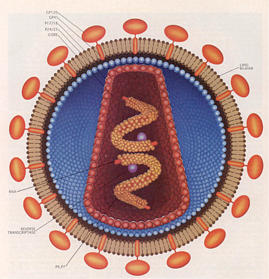Microbiology/Immunology 510 - Mathematical Modeling of Infectious Diseases
NOTE: THIS COURSE IS USUALLY OFFERED EVERY OTHER FALL TERM.
Please note that it will not be offered in the Fall
of 2004.
This is a 3 credit hour course.
|

|
 |
| A cartoon rendering of HIV-1. |
A mathematical model predicting disease outcome in HIV-1 infection |
Course Director:
Dr. Denise Kirschner
EMAIL for Dr. Kirschner:
kirschne@malthus.micro.med.umich.edu
Department of Microbiology and Immunology
Class meets: 10:00-11:30am on tuesday and thursdays there are 2
classrooms..one is set up for computer use (5631 Med Sci II), the other is a regular classroom
(2813 Med Sci II in the LRC area). Both are
in Medical Science Bldg II and easy to find. The first class will meet in 5631.
Things of interest for this course will be posted here.
COURSE CONTENT:
The objective of this course is to present a detailed introduction to modeling
host-pathogen interactions. We will briefly discuss modeling at the population
level, as these models represent some of the most classical results. We will
then focus on host-pathogen interactions within the host.
We will explore such pathogens as HIV, Mycobacterium tuberculosis,
Helicobacter pylori .
We will focus mainly on in-host models of viral infections, as most of the
modeling has been done in this area in the past decade. We will however,
discuss models of bacterial and parasitic infections as well. Current
literature will be assigned and discussed in class throughout the course.
COURSE OBJECTIVES:
Our
specific goals for the course as outlined as follows:
1. Illustrate the broad range of infectious disease problems which can be
modeled mathematically.
2. Learn the skill of gleaning and synthesizing the
literature to study a particular question.
3. Create mathematical models from
non-mathematical descriptions of problems.
4. Interpret the results of models
and evaluate their biological implications.
5. Show the necessity of simplification and approximation in
models and identify their effects.
6. Enhance computer skills and the use of the internet through email
and the world wide web.
PRE-REQUSITE INFORMATION
Background Some basic understanding of Biology
pre-requisites
As this course is intended for a broad audience, it will include solid
introductions to the mathematics, microbiology and immunology as needed.
Student will be required to have Calculus I and II, but it will be helpful to
have some experience with differential equations and/or linear algebra.
NOTE: If you are NOT sure of your background, then contact instructor for approval.
Text/Readings:
There is no required textbook for the course.
Supplemental Readings: ALL ARE ON RESERVE AT TAUBMAN MEDICAL LIBRARY
There will be outside
daily reading assignments from journal articles, book chapters and notes that I hand
out in class.
Background reading in specific areas are listed below. Most are available in the bookstore
or on reserve in the library.
Modeling text: by Leah Edelstein Keshet: Mathematical Models in Biology, Birhauser ISBN-0-07-554950-6
Immunology text: by Janeway and Travers: Immunobiology, 3rd or 4th edition ISBN 0-8153-2818-4
Microbiology text: "Mims' Pathogenesis of Infectious Diseases" authors: Mims, Dimmock, Nash,
and Stephen. Academic Press. Paperback cost roughly $23.00.
Mathematics texts: There are two. If you have not had differential equations (in a while or ever)
then Boyce and DiPrima "Elementary differential equations", 6th edition. It is a good background book that reads easily. If you have had DE, then
I suggest (my favorite math book) By Steve Strogatz entitled: nonlinear dynamics and Chaos with
applications to Physics, Biology, Chemistry and Engineering, ISBN-0-201-54344-3.
One strongly recommended general reading for everyone is by Laurie Garrett, entitled:
The Coming Plague (soft cover).
It costs about 12 dollars, and really
gives an exciting "big picture" humanistic aspect of the subject.
TENTATIVE SYLLABUS
Week 1: Intro to mathematical modeling
Week 2: Intro to Immunology
Week 3: Intro to Pathogenesis : Bacterial, Viruses and fungi & protozoa
Week 4: Intro to basic deterministic modeling techniques
Weeks 5&6: Intro to solving and exploring mathematical systems
Weeks 7&8&9: Mathematical Modeling of HIV-immune system
Weeks 10&11: Contrast with modeling biology systems: H. pylori and TB
Week 12: Intro PDE modeling
Grades Class attendance and participation will make
a difference in your grade. There may be short homework
assignments; and the course will have a written, in-class midterm
and a final project that
you should be working on during the entire semester. These will be presented in both
written and oral form on the last day of class, December 10th.
First HOMEWORK ASSIGNMENT:
Write a summary about yourself
including the following information:
name, classification, major, e-mail address. I also
would like to know what your (academic)
interests are, and why you are taking this class. What are your ultimate career goals with
your degree? What is your math background?
Anything else you would like to share/add about yourself is welcomed.
Don't forget, as part of this assignment, you MUST send this as an e-mail
message to me (email address above) before
the second class meeting.
Participation
I encourage you all to feel free to contact me over e-mail for ANY questions you may
have. I enjoy and expect
an interactive classroom, we hope that you all will participate, taking advantage
of a small class size, and will be challenged by this exciting course.
THINGS TO DOWNLOAD
Mathematica code for population growth
Mathematica code for competition
Mathematica code for LHS
Mathematica code for computing eigenvalues and eigenvectors
Mathematica code for predator prey model
Mathematica code for chemostat model
Mathematica code for S-I-R model


